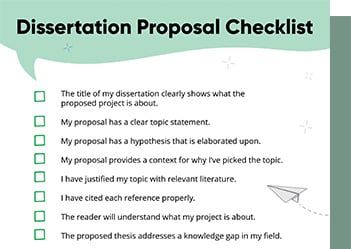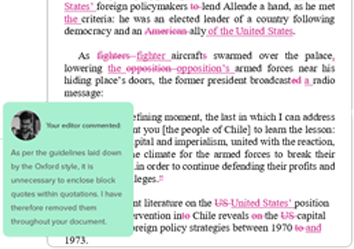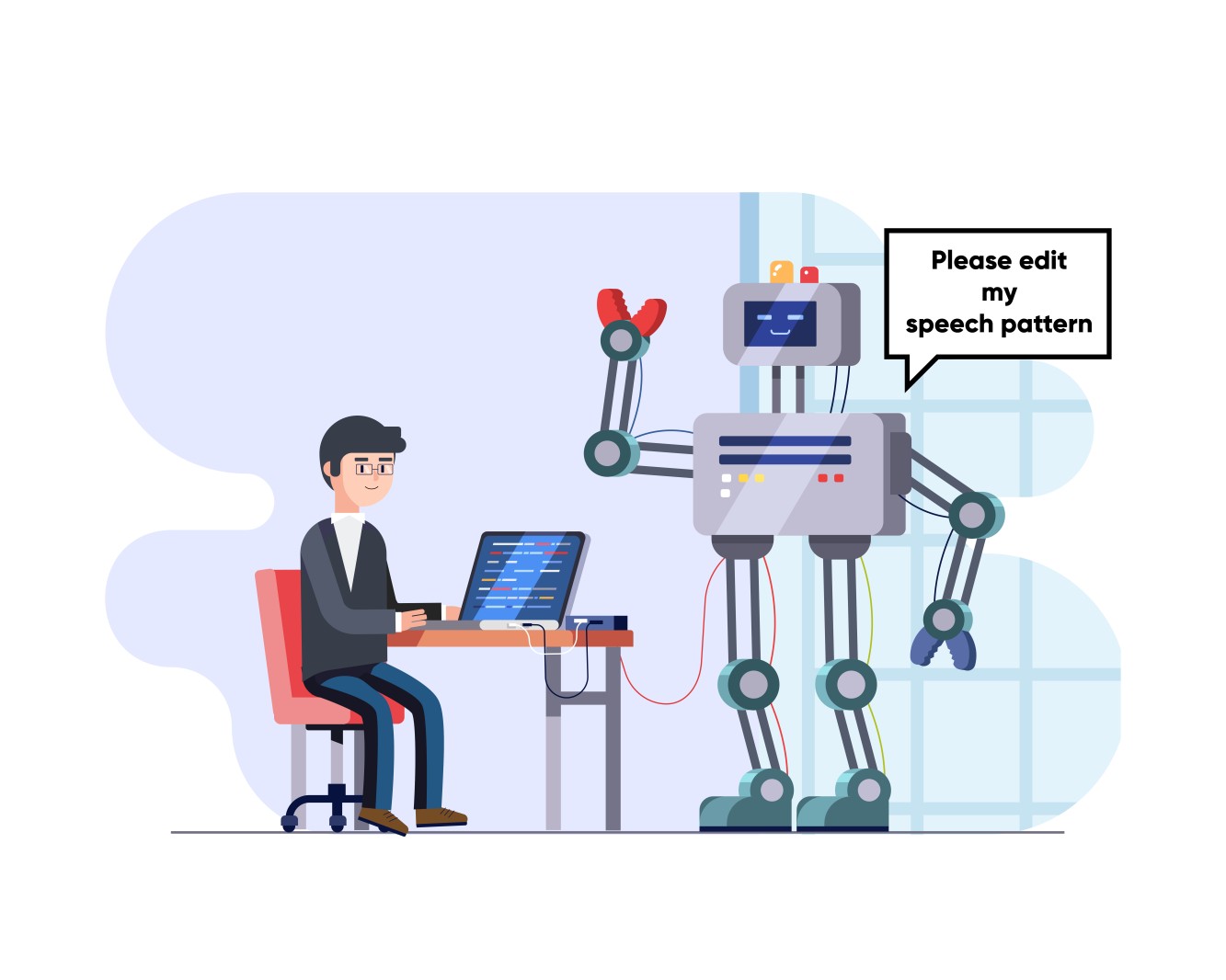- Tips to Self-Edit Your Dissertation
- Guide to Essay Editing: Methods, Tips, & Examples
- Journal Article Proofreading: Process, Cost, & Checklist
- The A–Z of Dissertation Editing: Standard Rates & Involved Steps
- Research Paper Editing | Guide to a Perfect Research Paper
- Dissertation Proofreading | Definition & Standard Rates
- Thesis Proofreading | Definition, Importance & Standard Pricing
- Research Paper Proofreading | Definition & Standard Rates
- Essay Proofreading | Options, Cost & Checklist
- Top 10 Paper Editing Services of 2024 (Costs & Features)
- Top 10 Essay Checkers in 2024 (Free & Paid)
- Top 10 English Correctors to Perfect Your Text in 2024
- 10 Advanced AI Text Editors to Transform Writing in 2024
- Personal Statement Editing Services: Craft a Winning Essay
- College Essay Review: A Step-by-Step Guide (With Examples)
- Top 10 College Essay Review Services: Pricing and Benefits
- How to Edit a College Admission Essay (8-Step Guide)
- Improve Academic Writing: Types, Tips, Examples, Services
- How to Use AI to Write Research Papers: A Step-by-Step Guide
- How to Write an Assignment: A Step-by-Step Guide for Students
- AI Proofreading Services: Meaning, Benefits & Best Tools
- 10 Best Proofreading Services Online for All in 2025
- Top 10 Recommendation Letter Editing Services | Best Picks
- How to Format an Appendix: APA and MLA
- Top 10 Online Thesis Editing and Proofreading Services
- What is Academic Editing? Meaning, Types & Importance
- Top 10 AI Proofreaders to Perfect Your Writing in 2025
- What Is a Thesis: How to Write a Thesis with Examples
- Top 10 Academic Proofreading Services (2025 Update)
- Research Paper Outline: Free Templates & Examples to Guide You
- How to Write a Research Paper: A Step-by-Step Guide
- How to Write a Lab Report: Examples from Academic Editors
- Research Methodology Guide: Writing Tips, Types, & Examples
- The 10 Best Essential Resources for Academic Research
- 100+ Useful ChatGPT Prompts for Thesis Writing in 2024
- Best ChatGPT Prompts for Academic Writing (100+ Prompts!)
- Sampling Methods Guide: Types, Strategies, and Examples
- Independent vs. Dependent Variables | Meaning & Examples
- Understanding Verbatim Plagiarism: Copy, Paste, Regret
- What Is a Journal Article and How to Write a Journal Article
- How to Use AI to Write Research Papers: A Step-by-Step Guide
- Top 10 AI Tools for Research in 2025 (Fast & Efficient!)
- What Is a Research Proposal: A Detailed Guide
- How to Format an Appendix: APA and MLA
- What Is an Appendix In a Paper?
- Types of Journals in Research and Their Features
- How to Write a Research Proposal (Step-by-Step)
- How to Cite an Artwork: APA, MLA, & Chicago
- Difference Between Paper Editing and Peer Review
- How to Handle Journal Rejection: Essential Tips
- Editing and Proofreading Academic Papers: A Short Guide
- How to Carry Out Secondary Research
- The Results Section of a Dissertation
- Final Checklist: Is My Article Ready for Submitting to Journals?
- Types of Research Articles to Boost Your Research Profile
- How does LaTeX based proofreading work?
- How to Improve Your Scientific Writing: A Short Guide
- Chicago Title, Cover Page & Body | Paper Format Guidelines
- How to Write a Thesis Statement: Examples & Tips
- Chicago Style Citation: Quick Guide & Examples
- Research Paper Outline: Free Templates & Examples to Guide You
- The A-Z Of Publishing Your Article in A Journal
- What is Journal Article Editing? 3 Reasons You Need It
- How to Cite a Book in APA Style | Format & Examples
- How to Start a Research Paper | Step-by-step Guide
- APA Citations Made Easy with Our Concise Guide for 2024
- A Step-by-Step Guide to APA Formatting Style (7th Edition)
- Academic Writing in 2024: 5 Key Dos & Don’ts + Examples
- How to Write a Lab Report: Examples from Academic Editors
- What Are the Standard Book Sizes for Publishing Your Book?
- MLA Works Cited Page: Quick Tips & Examples
- 2024’s Top 10 Thesis Statement Generators (Free Included!)
- Top 10 Title Page Generators for Students in 2024
- What Is an Open Access Journal? 10 Myths Busted!
- Primary vs. Secondary Sources: Definition, Types & Examples
- How To Write a College Admissions Essay That Stands Out
- APA Journal Citation: 7 Types, In-Text Rules, & Examples
- What Is Predatory Publishing and How to Avoid It!
- Independent vs. Dependent Variables | Meaning & Examples
- How to Write a Strong Dissertation & Thesis Introduction
- How to Cite a Book in MLA Format (9th Edition)
- How to Cite a Website in MLA Format | 9th Edition Rules
- 10 Best AI Conclusion Generators (Features & Pricing)
- Top 10 Academic Editing Services of 2024 [with Pricing]
- How to Create the Perfect Thesis Title Page in 2024
- What Is Accidental Plagiarism & 9 Prevention Strategies
- What Is Self-Plagiarism? (+ 7 Prevention Strategies!)
- Understanding Verbatim Plagiarism: Copy, Paste, Regret
- Improve Academic Writing: Types, Tips, Examples, Services
- What Is a Journal Article and How to Write a Journal Article
- What Is Paraphrasing Plagiarism and How to Avoid It
- What Is Expository Writing? Types, Examples, & 10 Tips
- Academic Research Ethics & Rules Simplified for All
- Complete Guide to MLA 9th Format
- Top 10 Online Dissertation Editing Services of 2025
- How to Write a Dissertation & Thesis Conclusion (+ Examples)
- What Is a Peer Review & 8 Types of Peer Review Processes
- 50 Best Essay Prompts for College Students in 2025
- What Is an Annotated Bibliography & Writing One Using AI
- What Is an Appendix In a Paper?
- Types of Journals in Research and Their Features
- 5 Effective Personal Statement Examples & Templates
- 100+ Writing Prompts for College Students (10+ Categories!)
- What Is a Thesis: How to Write a Thesis with Examples
- What Is Plagiarism? Meaning, Types & Examples
- How to Write a Research Proposal (Step-by-Step)
- Preventing Plagiarism in Your Thesis: Tips & Best Practices
- Final Submission Checklist | Dissertation & Thesis
- 7 Useful MS Word Formatting Tips for Dissertation Writing
- How to Write a MEAL Paragraph: Writing Plan Explained in Detail
- How does LaTeX based proofreading work?
- Em Dash vs. En Dash vs. Hyphen: When to Use Which
- 2024’s Top 10 Self-Help Books for Better Living
- Top 10 Paper Editing Services of 2024 (Costs & Features)
- 100+ Useful ChatGPT Prompts for Thesis Writing in 2024
- Best ChatGPT Prompts for Academic Writing (100+ Prompts!)
- MLA Works Cited Page: Quick Tips & Examples
- 2024’s Top 10 Thesis Statement Generators (Free Included!)
- Top 10 Title Page Generators for Students in 2024
- 10 Advanced AI Text Editors to Transform Writing in 2024
- Top 10 Academic Editing Services of 2024 [with Pricing]
- Know Everything About How to Make an Audiobook
- How to Create the Perfect Thesis Title Page in 2024
- Mastering Metaphors: Definition, Types, and Examples
- 10 Best Paid & Free Citation Generators (Features & Costs)
- The 10 Best Free Character and Word Counters of 2025
- What Is an Annotated Bibliography & Writing One Using AI
- Top 10 AI Proofreaders to Perfect Your Writing in 2025
- What Is Plagiarism? Meaning, Types & Examples
- Top 10 Academic Proofreading Services (2025 Update)
- Citing References: APA, MLA, and Chicago
- How to Cite Sources in the MLA Format
- MLA Citation Examples: Cite Essays, Websites, Movies & More
- Chicago Title, Cover Page & Body | Paper Format Guidelines
- Chicago Style Citation: Quick Guide & Examples
- Citations and References: What Are They and Why They Matter
- APA Headings & Subheadings | Formatting Guidelines & Examples
- Formatting an APA Reference Page | Template & Examples
- How to Create an MLA Title Page | Format, Steps, & Examples
- How to Create an MLA Header | Format Guidelines & Examples
- MLA Annotated Bibliography | Guidelines and Examples
- APA Website Citation (7th Edition) Guide | Format & Examples
- APA Citations Made Easy with Our Concise Guide for 2024
- APA Citation Examples: The Bible, TED Talk, PPT & More
- APA Header Format: 5 Steps & Running Head Examples
- A Step-by-Step Guide to APA Formatting Style (7th Edition)
- How to Write an Abstract in MLA Format: Tips & Examples
- APA Journal Citation: 7 Types, In-Text Rules, & Examples
- How to Cite a Book in MLA Format (9th Edition)
- How to Cite a Website in MLA Format | 9th Edition Rules
- 10 Best Paid & Free Citation Generators (Features & Costs)
- Complete Guide to MLA 9th Format
- Research Paper Format: APA, MLA, & Chicago Style
- 5 Reasons Why It Is Important To Cite Your Sources
- APA Title Page Format Simplified | Examples + Free Template
- How to Cite an Artwork: APA, MLA, & Chicago
- 10 Best Free Plagiarism Checkers | Accurate & Reliable Tools
- Writing a Dissertation Proposal
- The Acknowledgments Section of a Dissertation
- The Table of Contents Page of a Dissertation
- The Introduction Chapter of a Dissertation
- Tips to Self-Edit Your Dissertation
- The Results Section of a Dissertation
- Preventing Plagiarism in Your Thesis: Tips & Best Practices
- Final Submission Checklist | Dissertation & Thesis
- The Only Dissertation Toolkit You’ll Ever Need!
- 7 Useful MS Word Formatting Tips for Dissertation Writing
- 5 Thesis Writing Tips for Master Procrastinators
- The 5 Things to Look for in a Dissertation Editing Service
- Top 10 Dissertation Editing & Proofreading Services
- Why is it important to add references to your thesis?
- Thesis Editing | Definition, Scope & Standard Rates
- Expert Formatting Tips on MS Word for Dissertations
- A 7-Step Guide on How to Choose a Dissertation Topic
- 350 Best Dissertation Topic Ideas for All Streams in 2024
- A Guide on How to Write an Abstract for a Research Paper
- Dissertation Defense: What to Expect and How to Prepare
- Creating a Dissertation Title Page (Examples & Templates)
- Top 10 Online Dissertation Editing Services of 2025
- A Beginner’s Guide to How to Write a Dissertation in 2025
- What Is a Research Proposal: A Detailed Guide
- How to Write a Dissertation Literature Review: Tips and Structure
- What Is a Thesis: How to Write a Thesis with Examples
- Essential Research Tips for Essay Writing
- How to Write a MEAL Paragraph: Writing Plan Explained in Detail
- How to Write a Thesis Statement: Examples & Tips
- What Is a Mind Map? Free Mind Map Templates & Examples
- How to Write an Essay Outline: Free Template & Examples
- How to Write an Essay: 8 Simple Steps with Examples
- Expository Essay: Structure, Tips, and Examples
- Guide to Essay Editing: Methods, Tips, & Examples
- Narrative Essays: Structure, Tips, and Examples
- How to Write an Argumentative Essay (Examples Included)
- How to Write a Conclusion for an Essay (Examples Included!)
- How to Write an Impactful Personal Statement (Examples Included)
- Literary Analysis Essay: 5 Steps to a Perfect Assignment
- How to Write a Compare and Contrast Essay: Tips & Examples
- Top 10 Essay Checkers in 2024 (Free & Paid)
- 100 Best College Essay Topics & How to Pick the Perfect One!
- College Essay Format: Tips, Examples, and Free Template
- 10 Best AI Essay Outline Generators of 2024
- Personal Statement Editing Services: Craft a Winning Essay
- College Essay Review: A Step-by-Step Guide (With Examples)
- Top 10 College Essay Review Services: Pricing and Benefits
- How to Write an Assignment: A Step-by-Step Guide for Students
- The Four Main Types of Essay | Quick Summary with Examples
- How to Write an Essay Introduction | 4 Examples & Steps
- 10 Best AI Essay Writing Tools in 2025
- How to Write a Descriptive Essay | Examples and Structure
- Structure of an Essay: 5 Tips to Write an Outstanding Essay
- Types of Introductions and Examples
- Top 10 Essay Editing Services of 2025
- The Best Essay Graders of 2025 That You Can Use for Free!
- What Is an Essay? A Comprehensive Guide to Structure and Types
- Top 10 Free Essay Writing Tools for Students in 2025
- How to Write an Essay Header: MLA and APA Essay Headers
Still have questions? Leave a comment

Checklist: Dissertation Proposal
Enter your email id to get the downloadable right in your inbox!
[contact-form-7 id="12425" title="Checklist: Dissertation Proposal"]
Examples: Edited Papers
Enter your email id to get the downloadable right in your inbox!
[contact-form-7 id="12426" title="Examples: Edited Papers"]Need
Editing and
Proofreading Services?

How to Write a Dissertation Literature Review: Tips and Structure
 Jul 02, 2025
Jul 02, 2025 5
min read
5
min read
Writing a dissertation literature review can seem challenging, but it is an essential part of your academic research. It helps you connect the dots by showing how different studies in the field relate to each other.
Literature reviews provide a foundation for dissertations by summarizing existing research. They demonstrate the context of your work within your field.
This article offers detailed guidance on how to write a dissertation literature review, explaining literature review objectives, structure, and key tips for success.
Research Can Be Tough, But Editing It Need Not Be. Get Editing Support. Learn More
What is a literature review?
A literature review is a comprehensive survey of existing research, theories, and findings related to your dissertation topic. It evaluates and collates input from relevant sources to provide a framework for your research.
By exploring current knowledge and gaps in your area of study, the literature review justifies why your research is necessary and establishes its importance. It gives your independent research a solid foundation and makes references clear and relevant.
Objectives of a literature review
The objectives of a literature review go beyond mere summary; it requires you to critically assess sources to give your research context and meaning. Its key objectives include:
- Familiarity with the topic and your field: Show that you understand your academic field well. Identifying key concepts and theories relevant to your research topic is crucial.
- Identifying gaps: Recognizing the shortfalls of existing research helps reveal the unique contribution of your dissertation.
- Establishing a theoretical framework: Define the concepts and theories that will guide your study. This will help you develop the scope of your research without including unnecessary points or excluding important aspects of your research work.
- Justifying the need for your research: Show why your research is necessary by highlighting limitations in previous studies. For this, begin by analyzing existing research findings and then highlight what your research work is likely to address.
How to structure a dissertation literature review
A well-organized literature review structure helps you present information logically and cohesively. There are several approaches to structuring a literature review. The most common approaches include:
-
Chronological approach
A chronological approach organizes the literature review chronologically, from the earliest to the most recent studies. It arranges sources by their publication dates, showing how the research on a topic has evolved.
This literature review outline works well when the development of a theory, method, or perspective is essential to your review.
-
Thematic approach
The thematic approach groups the literature by theme or topic, which enables researchers to undertake a focused analysis of specific issues. It organizes information around specific themes or issues relevant to your research problem.
By grouping sources based on similar topics or themes, you can analyze and compare the perspectives of different researchers within each area.
-
Methodological approach
This approach categorizes the literature based on the research methodologies used.
Since this method allows you to arrange sources by their research methodologies, it is useful when you need to compare methods used in previous studies or examine the strengths and shortcomings of various approaches to your research question.
Steps to writing an effective literature review
A literature review, which is a critical analysis of scholarly articles, books, and other sources relevant to a specific research topic, requires a researcher’s full attention.
To develop a strong literature review, follow these steps to maintain focus.
Step 1: Define your research problem and objectives
Before diving into the literature, clearly define your research problem and objectives. This will help you focus your search and ensure that the literature you review is relevant to your study.
Understanding your focus will help you identify the most relevant sources for your dissertation literature review.
Step 2: Conduct a comprehensive literature search
Conduct a thorough literature search using a variety of databases, such as Google Scholar, JSTOR, and PubMed. Use relevant keywords and search terms to identify potential sources. The success of your review depends on a thorough literature search.
Including both classic works and recent studies to capture a balanced view of the research landscape is recommended.
Step 3: Evaluate and select sources
Not all sources can be considered equal. Evaluate the quality and relevance of each source. Select sources that are credible, up-to-date, and directly related to your research topic.
Selecting high-quality sources ensures that your literature review is well-supported and sounds authoritative in your field of work.
Step 4: Organize the review logically
Choosing a coherent structure is key to a successful review. Once you have selected your sources, organize them logically based on your chosen structure (chronological, thematic, or methodological).
This structure will determine the flow of your writing and help readers understand how each source contributes to your topic.
Step 5: Write and revise your literature review
Write a clear, concise introduction that outlines the purpose of your review. When you start writing, focus on integrating sources rather than summarizing them individually. Finalize and present the literature according to your chosen structure after consolidating the key findings and identifying gaps.
Conclude your review by summarizing the main points and highlighting the implications for your research. Take a look at the language of your review and confirm that each section supports your objectives. Also, seek feedback from peers or mentors to understand if changes are needed.
Tips for writing a successful literature review
Writing a literature review can be complex, but the following literature review tips can streamline the process.
With these strategies, you can write a strong and effective literature review that boosts the overall quality of your dissertation.
- Revising and seeking feedback: Revise your literature review multiple times to ensure clarity, coherence, and accuracy. Seek feedback from peers, supervisors, or writing centers to improve your writing. This way, you can address potential problems in your research.
- Managing references and citations: Use a reliable citation management tool, such as Zotero, EndNote, or Mendeley, to organize your references and generate accurate citations in the required format (e.g., APA, MLA, Chicago). This guarantees academic integrity.
Developing a dissertation literature review is a vital step in proving your research project’s effectiveness and defining its relevance within your academic field. It helps you showcase your understanding of the field. Though the process can be challenging, following a structured approach makes it manageable.
If you have spent countless hours on research, let PaperTrue support you with professional editing and proofreading services. Our expert editors will refine your writing and ensure your literature review makes a lasting impact.
Here are some other articles you might want to check out:






